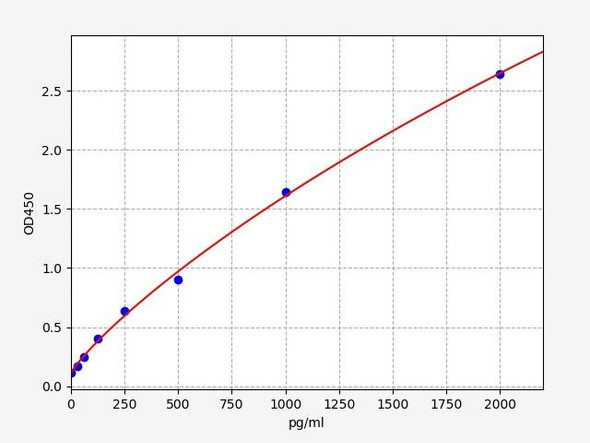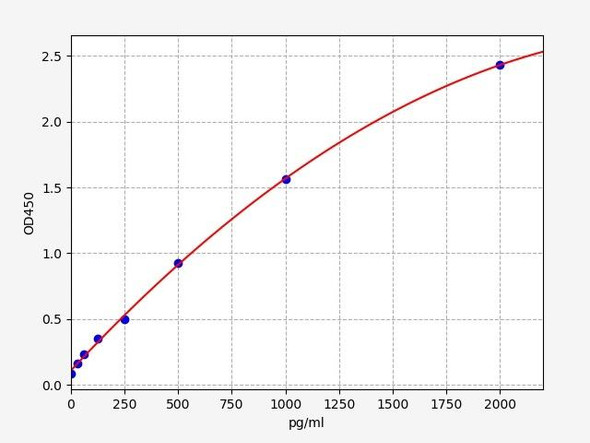Description
| Product Name: | Bovine BDNF ELISA Kit |
| SKU: | AEKE03004 |
| Reactivity: | Bovine |
| Synonyms: | Neurotrophin, Abrineurin |
| Assay Type: | Sandwich ELISA |
| Sensitivity: | 0.062 ng/mL |
| Standard: | 10 ng/mL |
| Range: | 0.16-10 ng/mL |
| Sample Type: | Serum, Plasma, Tissue Homogenates, Cell Lysates, Cell Culture Supernates and Other Biological fluids |
| Assay Length: | 3.5h |
| Research Area: | Cytokine, Infection Immunity, Neuro Science |
| Uniprot: | Q95106 |
| Component | Quantity | Storage | |
| 48T | 96T | ||
| Pre-Coated Microplate | 6 strips × 8 wells | 12 strips × 8 wells | 4°C–20°C |
| Standard (Lyophilized) | 1 vial | 2 vials | 4°C–20°C |
| Biotinylated Antibody (100×) | 60 μL | 120 μL | 4°C–20°C |
| Streptavidin-HRP (100×) | 60 μL | 120 μL | 4°C–20°C |
| Standard/Sample Diluent Buffer | 10 mL | 20 mL | 4°C–20°C |
| Biotinylated Antibody Diluent | 6 mL | 12 mL | 4°C–20°C |
| HRP Diluent | 6 mL | 12 mL | 4°C–20°C |
| Wash Buffer (25×) | 10 mL | 20 mL | 4°C–20°C |
| TMB Substrate Solution | 6 mL | 10 mL | 4°C–20°C (store in dark) |
| Stop Reagent | 3 mL | 6 mL | 4°C–20°C |
| Plate Covers | 1 piece | 2 pieces | Room Temperature |
This assay utilizes a sandwich enzyme-linked immunosorbent assay (ELISA) technique. The microtiter plate included in this kit is pre-coated with a capture antibody specific for Cattle BDNF. Standards and samples are added to the wells, followed by the addition of a biotin-conjugated detection antibody specific to Cattle BDNF.
Subsequently, Avidin conjugated to Horseradish Peroxidase (HRP) is added to each well and incubated. After washing to remove unbound reagents, a TMB (3,3′,5,5′-Tetramethylbenzidine) substrate solution is added. Wells containing Cattle BDNF, the biotin-labeled antibody, and the HRP-Avidin complex will develop a blue color due to enzymatic conversion of the substrate.
The reaction is terminated by the addition of sulfuric acid, resulting in a color change from blue to yellow. The optical density (OD) is measured at 450 nm ± 10 nm using a spectrophotometer. The concentration of Cattle BDNF in the samples is determined by comparing the OD values to a standard curve generated from known concentrations.
| Standard Curve: |
|
|||||||||||||||||||||||||||
| Linearity: |
|
|||||||||||||||||||||||||||
| Recovery: |
|
|||||||||||||||||||||||||||
| Precision: |
Intra-assay Precision (within-run): Coefficient of variation (CV) < 8%
Inter-assay Precision (between-run): Coefficient of variation (CV) < 10% |
*Note: The following protocol is a general guideline. Please refer to the specific protocol provided with your kit, as procedures may vary by batch or lot.
| Step | Procedure |
| 1. | Equilibrate the kit components to room temperature. Add 100 μL of the standard (serially diluted as instructed) or 100 μL of sample to each well. Incubate at 37°C for 80 minutes. |
| 2. | Discard the solution from the wells. Wash the wells 3 times with 200 μL of 1× Wash Buffer per well. Blot the plate onto clean absorbent paper. Add 100 μL of 1× Biotinylated Antibody Working Solution to each well and incubate at 37°C for 50 minutes. |
| 3. | Repeat the washing step as above. Add 100 μL of 1× Streptavidin-HRP Working Solution to each well. Incubate at 37°C for 50 minutes. |
| 4. | Wash the plate 5 times with 200 μL of 1× Wash Buffer per well. Blot dry. Add 90 μL of TMB Substrate Solution to each well and incubate in the dark at 37°C for 20 minutes. |
| 5. | Add 50 μL of Stop Solution to each well. Mix thoroughly using a plate shaker for 1 minute. Measure absorbance immediately at 450 nm. |
Proper sample preparation is critical for optimal ELISA performance. Below are guidelines for preparing various sample types.
| Sample Type | Preparation Protocol |
| Serum | Collect blood into a serum separator tube. Allow clotting for 2 hours at room temperature or overnight at 4°C. Centrifuge at 1000 × g for 20 minutes. Use fresh serum immediately or store aliquots at -20°C or -80°C. Avoid repeated freeze–thaw cycles. |
| Plasma | Collect blood using EDTA or heparin as anticoagulants. Centrifuge at 1000 × g at 2–8°C for 15 minutes within 30 minutes of collection. Use immediately or store aliquots at -20°C or -80°C. Avoid repeated freeze–thaw cycles. |
| Tissue Homogenates |
1. Rinse tissue with ice-cold PBS to remove blood and weigh. 2. Mince and homogenize in fresh lysis buffer (typically PBS) using a glass homogenizer on ice. 3. Sonicate the mixture until a clear solution is obtained. 4. Centrifuge at 10,000 × g for 5 minutes. Collect the supernatant and use immediately or store at ≤ -20°C. |
| Cell Lysates |
1. Wash adherent cells with PBS, detach using trypsin, then centrifuge at 1000 × g for 5 minutes. 2. Wash cells 3 times with PBS. 3. Resuspend in lysis buffer at 10⁷ cells/mL. Sonicate if needed. 4. Centrifuge at 1500 × g for 10 minutes at 2–8°C. Use the supernatant immediately or store at ≤ -20°C. |
| Urine | Collect midstream morning urine into a sterile container. Centrifuge to remove debris. Use immediately or aliquot and store at ≤ -20°C. Avoid repeated freeze–thaw cycles. |
| Saliva | Collect using a saliva collection device. Centrifuge at 1000 × g for 15 minutes at 2–8°C. Remove debris and use immediately or store aliquots at ≤ -20°C. Avoid repeated freeze–thaw cycles. |
| Feces | Collect more than 50 mg of dried feces. Suspend in PBS at a 1:9 ratio (w:v), sonicate, and centrifuge at 5000 × g for 10 minutes. Use the supernatant for the assay. |
| CSF (Cerebrospinal Fluid) | Centrifuge to remove particulates. Use immediately or store aliquots at ≤ -20°C. Avoid repeated freeze–thaw cycles. |
| Cell Culture Supernatant | Centrifuge at 1000 × g for 20 minutes. Collect the supernatant. Use immediately or store at -20°C or -80°C. Avoid repeated freeze–thaw cycles. |






